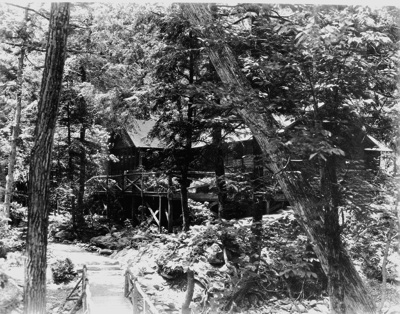Off of Skyline Drive, deep in Shenandoah National Park, is a small cabin sometimes referred to as the Brown House. This name was used to differentiate it from the owner’s other residence at the time, The White House. In 1929, then President Herbert Hoover established a fishing camp at the headwaters of the Rapidan River in Madison County, VA. Spring through fall, Rapidan Camp guided tours are open to visitors and you can make a reservation in advance at Recreation.gov or by calling 877-444-6777.
If you grew up in Virginia, visited, or lived here for any length of time, you are likely aware of the more famous residences of our presidents including Mt. Vernon, Monticello, Montpelier, Ashlawn-Highland, Poplar Forest, and even maybe Teddy Roosevelt’s Pine Knot. A native Virginian, I was surprised to hear about the Hoover Camp, also referred to as Rapidan Camp, and couldn’t wait to go.
My hiking partner and I chose a weekday when the temperatures were well into the 90s in central Virginia. As you enter the Skyline Drive at the Swift Run Gap Entrance Station and headed north, you may want to intermittently watch the car’s outside temperature gauge as by the time we parked at Milam Gap Trailhead (Mile 52.8) the reading was a full twenty degrees lower.
Once you’ve checked your backpack to make sure it contains your trail map (http://www.nps.gov/shen/upload/Milam-Gap.pdf), the necessary quarts of water (allow a quart per hour), snacks and other essentials you’ll cross the road to join the AT for a few minutes before the trail starts. The day we visited, a gentle shower reminded us of the rains of the night before and the chance that the trail would be wet. If you have a trekking pole, this is a good hike to use it on, although perfectly manageable without.
***
Watch for the metal trail markers to direct you on the Mill Prong Trail to Rapidan Camp. The first part of the hike was relatively level and went through the remnants of an apple orchard, with a fern covered forest floor, before starting to descend to the camp (870 feet over 2 miles). The occasional trillium provided a pop of color in the otherwise overwhelming green environment.
The trail is well-maintained and is a typical mix of roots and rocks. On our way down we made several stream crossings, each with a set of stepping stones to avoid wading. The view at Big Rock Falls was definitely worth a short break to eat an energy bar.
The approximately two-mile trail ends at the fire road for Rapidan Camp. This road is the access point for day staff and visitors coming via van from the Shenandoah National Park Harry F. Byrd, Sr. Visitor Center (540-999-3500). You’ll want to take their 1:30 arrival time into consideration when planning your visit.
After a visit to the in-ground portable toilet housed within a small brown shed, cross back over the bridge and follow the walkway into the Camp. Once a village of 13 buildings, only three remain. A walking loop connects the sites of these structures and interpretive signage does a good job of explaining what is missing.
A Shenandoah National Park staffer will greet you when you arrive and let you know when the next tour of the Brown House will start. Make sure to visit the adjacent Prime Minister’s cabin either before or after your tour. It is an interpretive center where you can learn more of the history and workings of the camp.
After explaining that the Hoover’s had paid for the land and materials themselves and that the Marines had offered to build the camp as part of their training exercises, our guide took us inside the Brown House. A simple log cabin with a large great room divided into two sections, two bedrooms, and a bathroom hidden from view completed the tour. Thanks to historic images, the portions of the cabin that were photographed during the Hoover’s tenure have been furnished to recreate the cabin’s 1929 appearance.
Visitors to the park and the Camp come from near and far. Our tour group consisted of a young couple from Williamsburg VA that had spent the night camping in the park, and a family from eastern Europe staying at Big Meadows Lodge. After a quick picnic lunch and conversation with other hikers on the large shaded deck that surrounds the Brown House, take a last look at the favorite fishing grounds of our 31st president. You’ll exited the camp, passing the third house, The Creel, which now provides housing for summer interns.
Leaving Camp, you’ll have two trail choices. You can either retrace your route along the Mill Prong Trail (total of 4 miles in and back) or follow the longer Laurel Prong Trail (7.3 mile loop). If you chose Mill Prong, although decidedly uphill, you should find the hike back takes less time than the trip in.
The scenery is no less beautiful going in this direction, with large rock outcroppings and lush vegetation. Nearing the parking area, I thought about the gift the Hoovers’ had given not only to the future presidents that they hoped would use the camp they donated to the government, but to all of us. At the time they built the camp, there was a competition for a National Park to be established on the east coast. By choosing to locate their camp in Madison County, they helped ensure that the park would be what we know today as the Shenandoah National Park.
